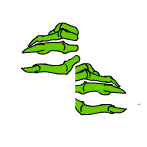Duality of Human Nature In Dr. Jekyll and Mr. Hyde
Created | Updated Sep 21, 2016
The people gathered at Times Square screamed in terror as the evil Mesthor loomed over them, his face a horrid scowl of contempt, his eyes blazing with fury. He aimed his laser blaster at a group of school children and prepared to fire. Just as he was about to shoot, the good and gentle superhero, Gabriel, appeared, his eyes the color of the sky, standing tall with his hands on his hips and a smile to charm anyone. Effortlessly he defeated the evil Mesthor, saving the children in a short but fierce battle, cheered on by the crowd. His people saved, his deeds rewarded, Gabriel flew off into the sunset, not to be seen again until the next emergency. However, as soon as he was out of sight, Gabriel removed his mask and the fallen Mesthor disappeared. All that remained was a normal man, with kind blue eyes and a horrid scowl. Little did the people know that hero and villain were one in this man.
The duality of human nature has always been a favorite topic in literature, tracked through the ages from as early as the first religious writings of various cultures before the birth of Christ. Most often, this duality has been portrayed through the conflicts between two different characters – a hero like Gabriel versus a villain like Mesthor – usually understood to be an external struggle. There have always been two opposing forces, one completely good and the other completely evil, exemplified in today’s literature by the basic plot of any comic book. Robert Louis Stevenson’s novella, Dr. Jekyll and Mr. Hyde, is worthy of its recognition as an original classic not because of its theme but because of the manner in which the theme is portrayed. Most of the characters in Dr. Jekyll and Mr. Hyde view Dr. Jekyll as the embodiment of good and Mr. Hyde as the embodiment of evil, but, like the bystanders who witness Gabriel and Mesthor’s battle, fail to realize these two opposites are actually one person. By combining good and evil in this person, Stevenson reveals that the duality of human nature runs deeper than good versus evil to rational versus irrational and reputation versus true nature.

The simplest interpretation of Dr. Jekyll and Mr. Hyde is to imagine Dr. Henry Jekyll as a good Victorian scientist intrigued by chemistry and fascinated by the transcendental elements of his field (Howes 477-479). Through his experiments, inspired by some noble cause, he was gradually transformed from a living saint into the dreadful Mr. Edward Hyde. In the beginning he had control over the process, but as time passed, the evil personality of Mr. Hyde, a wanted murderer, took over that of Dr. Jekyll and made it more difficult for the process to be reversed. In the end there was no good – no Dr. Jekyll – and all that was left was Mr. Hyde, the incarnation of pure evil.
This interpretation is as horrifying as it is fantastic. It is horrifying because people aim for the ideal of a good beyond the reach of evil – in this case Dr. Jekyll is the incorruptible good – and this interpretation indicates that such a good does not exist. It is fantastic because in order for Dr. Jekyll to transform into Mr. Hyde, some evil must have existed in Dr. Jekyll from the beginning. Dr. Jekyll himself supported this idea in his confession, where he called himself an “incongruous compound” of good and evil (Stevenson 109). In truth he had always been inspired by the idea of dual personalities and his experiments were meant to channel the good and the evil within himself into two different identities, each equipped with a body and personality of its own (Howes 477).
Unfortunately, the composite Dr. Jekyll instead “projects a concentrate of pure evil that becomes Hyde, who is smaller than Jekyll” (Nabokov 10). This difference in size reinforces the idea of Mr. Hyde as part of Dr. Jekyll, because a part must always be smaller than the whole. Along with Mr. Hyde remains a residue of the good in Dr. Jekyll, horrified by Hyde’s actions but unable to control them (Nabokov 11-12). The experiment failed because Dr. Jekyll’s “virtue slumbered” and did not claim its own body or identity (Stevenson 109).
Dr. Jekyll was responsible for his actions because, as good and evil both existed inside of him, he had the ability to choose to perform good or evil deeds. As he himself later admitted, if he had “approached [his] discovery in a more noble spirit,” willing the good to overpower the evil, he would have “come forth an angel instead of a fiend” (Stevenson 108). With the help of the drug he would have projected a concentrate of pure good. Because Hyde was, inversely, “a precipitate of pure evil,” he was unaware that good even exists, and therefore could not choose good (Nabokov 10). Capable only of choosing evil, he could not be held responsible for his actions anymore than an insane person would be held responsible today (Magill 831).

Mr. Hyde, “like an animal, seeks to fulfill himself without any of the restraints of social and moral codes” which, to him, do not exist (Magill 831). In this way he embodies what Sigmund Freud would later call the id, a primal source of instincts independent from all rational thought (García “Mr. Hyde” 1). Before Dr. Jekyll began his experiments, Hyde, the id of the composite person, was complemented by the ego and the superego that necessarily contribute to human nature. Dr. Jekyll, as the ego, was constantly torn between the primal urges of his id and what he knew was right through the super-ego, the morals of society (García “Mr. Hyde” 1). When Dr. Jekyll conducted his experiments he ignored his super-ego and catered only to his id, allowing himself to become this irrational person Hyde who had no conscience.
While examining the character of Dr. Jekyll as a responsible, rational gentleman, one begins to question whether he was really the good, noble physician he was generally perceived to be. His attorney, Mr. Utterson, came ironically close to the truth when he speculated privately about Jekyll’s relationship with Mr. Hyde, “[Jekyll] was wild when he was young; a long time ago to be sure; but” the existence of Hyde “must be […] the ghost of some old sin, the cancer of some concealed disgrace […]” (Stevenson 54).
In reality, unknown to most of the characters, Jekyll had lived “a double life, maintaining his respectability and gentility in public but indulging in unrestrained vice in private,” and was the epitome of the divided self (Howes 477). Robert Louis Stevenson presents truth of Jekyll’s double life as a means of commenting on the strict moral codes of Victorian society, which lead many men to commit themselves to hypocrisy (García “Dr. Jekyll” 1). Dr. Jekyll took this to another level with his experiments by attempting to literally be two different people. He hypothesized that the good personality could perform good works and find genuine enjoyment in them, unhindered by the vices and primitive urges of Hyde, like a super-ego independent from the id. Likewise Hyde, the evil person, could go his way, free from “the aspirations and remorse of his more upright twin,” the id forever satisfied with no sense of morality to hinder him. (Stevenson 105) The fatal flaw in this theory is the unfortunate ego, which still must choose between id and super-ego, neither of which can survive without it.
In Dr. Jekyll’s case the ego chose to side with the id, discarding morals and turning toward a life of spontaneity. Jekyll took much pleasure in his new creation: “when I looked upon that ugly idol [Hyde] in the [mirror], I was conscious of no repugnance, rather of a leap of welcome. This, too, was myself. […] it bore a livelier image of the spirit,” than the face Jekyll was accustomed to calling his own (Stevenson 108). He viewed Hyde as a means of fulfilling his most wicked desires, of escaping completely from the bonds of Victorian society, his reputation still safe and secure. Mr. Hyde was a haven where Jekyll believed he could hide his true nature, but in the end it was Hyde who revealed him as the villain he truly was (Nabokov 9). Cloaked under the countenance of Hyde, Dr. Jekyll allowed himself to commit a variety of heinous acts in direct violation of his conscience. It was not until one night when he went to bed as Jekyll and woke the next morning as Hyde that he realized Hyde had taken over (Magill 830).

Jekyll had struggled endlessly throughout his life to create and maintain a good reputation. Although he lived a double life, he managed to conform his character to the morals of Victorian society, so even if he did not always obey the Victorian moral code he at least felt guilty when he breached it. Because Hyde had no morals, when Jekyll permitted himself to become Hyde he began to reverse the process he had struggled so long to set in motion. As time went on he noticed that “only by a great effort as of gymnastics […] was [he] able to wear the countenance of Jekyll. At all hours of the day or night, […] if [he] slept, or even dozed for a moment in [his] chair, it was always as Hyde that [he] awakened” (Stevenson 121 – 122).
Once an individual gives in to temptation, it becomes even harder for that person to resist the same temptation a second time. Before long the sense of guilt is lost and the temptation no longer seems like temptation but like genuine desire. Dr. Jekyll allowed this to happen because once he had had a taste of the freedom of amoral youth he was no longer satisfied with the life of self-sacrifice he had pursued as a kind, middle-aged, upstanding physician (Stevenson 109).
The world was never oblivious of the existence of Hyde – Stevenson begins his tale with an account of Hyde’s disregard for morals told by an outsider, Mr. Enfield – and the more people saw his evil deeds the more they despised him. Because Mr. Hyde was the embodiment of Dr. Jekyll’s true nature, the reality of what Dr. Jekyll really was began to weigh more heavily in the public mind than the illusion of who he tried to be. Whenever Jekyll let down his guard, he found his true nature revealed again as Mr. Hyde, and then it was more difficult for him to revive his reputation as the good Dr. Jekyll. The culmination of this catastrophe occurred when a sudden transition into the form of Hyde forced Jekyll to seek the help of his more conventional colleague, Dr. Lanyon, who was so shocked by the revelation of Jekyll’s true nature he fell ill and died (Howes 479). Jekyll/Hyde later committed suicide to avoid discovery.
The tragic flaw in Dr. Jekyll was not the fact that as a composite being he possessed both good and evil, rationality and irrationality, and a reputation to go along with his true nature. Rather, the true tragedy of Stevenson’s unfortunate protagonist was his attempt to separate these qualities, which necessarily must coexist within one person. Realistically one cannot be wholly good or wholly evil, for humans are gifted with a conscience but subject to temptation. A person who acts irrationally can be a threat to himself or herself and to society, as is portrayed so vividly through the antics of Mr. Hyde. However, to deny one’s instincts is to place oneself in grave intellectual, emotional, and often physical danger. It is impossible to exist in society without developing a reputation based on others’ perceptions. Ideally, one should be honest in all dealings, allowing one’s reputation to reflect one’s true nature instead of contradicting it as in the case of Dr. Jekyll. This demands a great personal effort, but is facilitated in areas where society is less judgmental.
Society is a collection of human beings, individuals who may not be able to control the whole, but who can control their own actions. In Robert Louis Stevenson’s novella, Dr. Jekyll fails to take responsibility for his actions in time to save his own life and those of others in the community. His tragedy should serve as a reminder that each individual needs to take responsibility for his or her own actions, examining his or her character before judging anyone else. If one can learn to balance good with evil and rational with irrational behavior, one can live a healthy, honest, and productive life free from the strains of trying to project a reputation that contradicts one’s true nature. This is the fulfillment of the human being, all that anyone can hope for, the true and complete essence of salvation.

Works Consulted
Decker, Hannah S. “Freud, Sigmund.” World Book Online Americas Edition. February 23, 2002.
García, Joan Pere Roselló, and Oscar Sabata Teixidó. “How is Mr. Hyde Characterized and What Does He Stand For?” The Strange Case of Dr. Jekyll and Mr. Hyde. April 16, 2002.
---. “Main Theme: On a Symbolic Level, What is the Story About?” The Strange Case of Dr. Jekyll and Mr. Hyde. April 16, 2002.
---. “What are Dr. Jekyll’s Real Sins?” The Strange Case of Dr. Jekyll and Mr. Hyde. April 16, 2002.
Howes, Kelly King. “Stevenson: The Strange Case of Dr. Jekyll and Mr. Hyde.” Characters in 19th – Century Literature. Detroit: Gale Research Inc. 1993. 477 – 479.
Magill, Frank N., ed. “The Strange Case of Dr. Jekyll and Mr. Hyde.” Masterpieces of World Literature. New York: Harper Collins. 1989. 829 – 831.
Nathan and Yael. “Id, Ego, Super-ego.” Great Ideas in Personality. April 6, 2002.
Nabokov, Vladimir. “The Strange Case of Dr. Jekyll and Mr. Hyde.” Dr. Jekyll and Mr. Hyde. New York: Signet Classic. 1978. 7-37.
“Stevenson, Robert Louis.” The Columbia Electronic Encyclopedia. March 20, 2002.
Stevenson, Robert Louis. Dr. Jekyll and Mr. Hyde. New York: Signet Classic. 1978. 37-124.
